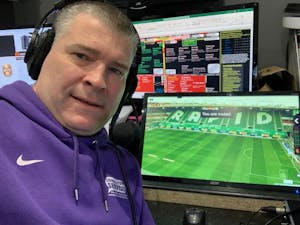The global expansion of digital technology has transformed the ability of sports organisations of all sizes to tap into uncharted territories.
Primarily, the growth of over-the-top (OTT) streaming, coupled with a significant increase in smartphone usage worldwide, has provided a direct route to followers of certain sports, leagues and clubs across international borders – and there are no signs of the momentum slowing down.
Indeed, research by YouGov Sport has found that more than a quarter of fans in 23 major markets already watch live streams of sports – with the highest percentages in China and Indonesia – and in the US alone, the number of people who watch live sport via OTT platforms is projected to rise from 57.5 million people this year to 90.7 million in 2025, according to Emarketer.
Internationalisation
Such trends have inevitably led to an increase in the internationalisation of sports coverage, according to Tom Read, vice-president of strategy and partnerships at Spalk, which provides a virtual commentary studio and media gateway, supporting the delivery of hundreds of sporting events per week for platforms worldwide.

“This internationalisation has allowed sports to be able to speak with more contextual relevance to their existing audience worldwide and drive increased engagement in that important core group,” Read says. “Also, they are able to engage and grow new audiences by tailoring content – be that live, highlights or clips – to specific audiences.”
While Read acknowledges that a number of factors have contributed to the growth of OTT delivery and therefore the internationalisation of sports content, a broader understanding across the industry of the importance of data has been key.
“Owning a direct relationship with your audience makes it easier to understand your customers,” he says. “For blue-chip sports leagues like the NFL and NBA, while they have global broadcast coverage, their Game Pass products are great services to satisfy their more engaged fans globally who want greater selection in their games than broadcasters can offer.
“With these leagues too, they have creatively used their existing international broadcast agreements as not only powerful tools to create, grow and maintain an active fan base, but also to act as a hugely important funnel to push fans into that next level of fandom and sign up for their OTT services where they can get access to every game.
“For lower-tier sports, owning and operating OTT platforms has been important to create, satisfy and grow an audience in new markets. The cost of entry of broadcasting has really helped drive growth in this space too.”
Revenue streams
Read cites the example of the Scottish Professional Football League, which has been able to establish a global broadcast strategy and additional revenue stream for its second-tier Championship. All SPFL games are available to international audiences online, broadcast using Pixellot AI cameras, which track games automatically without the need for an operator, to minimise production costs.
“Through strategic use of OTT and social media streaming platforms, sports leagues will potentially be able to create meaningful revenue streams in new markets,” Read adds.
However, the ability to reach new markets is no guarantee of building a worldwide fanbase. As Read stresses, the successful internationalisation of sports content requires a tailored approach to maximise engagement in specific markets.
“Knowing your audience is key, as well as making sure that you’re tailoring your content to that audience,” he says. “Key to this is ensuring that you’re speaking the language of the audience – whether that be through multilingual commentary and graphics or tailoring the content style correctly. Something that works for you in your local market may not work in a different market.”
As a starting point, ensuring the commentary is relevant to the specific audience is “the easiest and most effective way” to tailor the offering, Read explains.

“The commentator is one of the most important parts of a broadcast, and if you can ensure that the commentator has a correct language, accent or dialect for the audience you’re targeting, it will go a long way to ensure a successful international growth strategy,” he adds.
“This can open up meaningful revenue streams in the form of increasing media rights fees along with potential sponsorship and merchandising opportunities that come along with new audiences.”
For example, ahead of the 2020-21 Japanese B.League basketball season, the Philippines was identified as a potential growth market following the arrival of national team star Thirdy Ravena at San-en NeoPhoenix, one of Japan’s top clubs. The B.League started offering free coverage of games via their social platforms accompanied by commentaries in Tagalog, a central Philippine language, boosting the competition’s following in the country to such an extent that a local broadcaster acquired broadcast rights for the 2021-22 campaign.
Remote production
Delivering sports content in a market’s native language – wherever it is in the world – is supported by the growing use of cloud-based remote production tools.
As Read points out, gone are the days when the production and distribution of only an English-language world feed was sufficient.
“Approximately 75 per cent of the world doesn’t speak English, so there’s a huge market segment that’s often being left out,” he adds. “Tools like Spalk to add commentary, LIGR or Singular to add custom language graphics and WSC Sports to create highlights clips that are customisable for specific audiences have all been hugely important, and a number of sports leagues have seen success from doing this.”

A tailored approach is now considered by many to be a requirement in the OTT space, with audience expectations of a more personalised and relevant viewing experience continuing to grow. In this context, the successful delivery of sports content internationally can help to boost loyalty, expand a global following, and ultimately spread risk in a congested marketplace.
“Increasing competition seems to be the biggest challenge currently facing the rapidly growing sports OTT industry,” Read says. “Aside from the big tech companies that are moving more into the space, you also have the traditional broadcasters that are refining and improving their OTT sports strategies.
“This breeds opportunity too. If a sports OTT service can successfully grow subscribers across a number of key markets globally, while ensuring that the content they are broadcasting is correctly tailored to the audience in those markets, they will put themselves in a good position to succeed.”